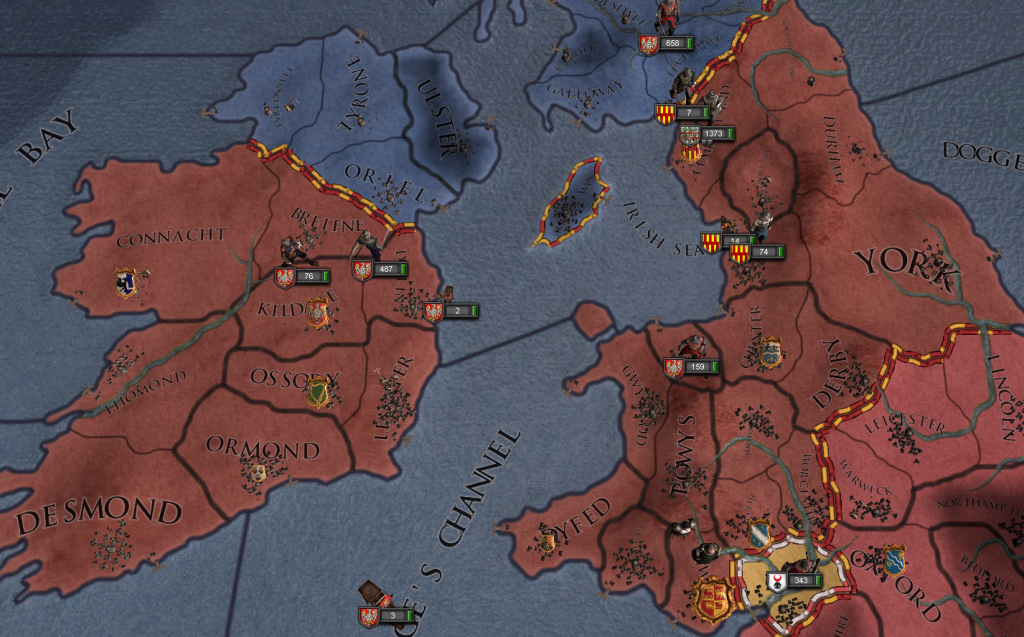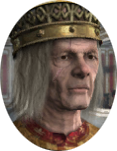Hey all! This is my first attempt at a CK2 AAR, so we'll see how it goes. It's going to be written in a narrative/history-book style chronicle. The twist, if it can be called that, which I have added is that the chronicle is going to be written successively by various court chaplains in the Kingdom of Wales who will all look retrospectively back at the former rulers of House Gwynn and do their best to sift through the sands of time and figure out who they were, what they were like, and so forth. Obviously this won't necessarily always be the most accurate interpretation, but that might make it more fun. I also plan to add in "later historian edits" to clarify ambiguities that I intentionally write in as part of the story, so that you guys aren't left confuse, but I'll put them up in spoiler tags for those that don't want to ruin the flavor (if there is any). Finally, by way of updates, I plan to try and update this as often as I can, and it will be on a reign by reign basis so without further ado here is the first update:
I begin this chronicle of the House of Gwynn in the year of our lord 1292. I, Brwt of Dyfed the Prince-Bishop of Dyfed, have been charged by his most illustrious majesty Caid II, Grand Prince of Wales, High King of Ireland, Duke of Deheubarth, Gwynedd, and Munster, Earl of Gwent, Gwynedd, Desmond, Thomond, and Powys, and Most Christian King of the Isles, with chronicling the House of Gwynn's ordained rise from minor Earls to their rightful place as Kings. Happily do I embrace this task given by his most glorious highness, but before I begin the chronicle in earnest, I shall endeavor to layout the state of our most magnificent kingdom as it stands today, so that all our posterity shall know of its glory.

The Kingdom of Wales-Ireland, popularly known as the United Kingdom circa 1292
This is the Kingdom of Wales and Ireland as it stands today. The United Kingdom, as it has come to be called, began in 1221 with the usurpation of the title of High King of Ireland by Branwaladr I, but that is a topic that shall be covered later. Since the unification the Kingdom has continued to expand to encompass what was formerly Northern England as well as parts of former Western England. The Royal Branch of House Gwynn still controls a majority of the land in Wales itself as well as significant portions of Southern Ireland as their personal demense, but even more of the kingdom is controlled by cadet branches. In fact, there is only about 20% of the kingdom that has been given out to a family other than the House of Gwynn. They are the second most powerful family in the kingdom and are descended, allegedly, from Morgan le Fay. This chronicler quietly wonders why such a potentially heretical family controls so much land within the kingdom, but I digress. House Morgan was given their ancestral seat in Glamorgan after being run out sometime in the years between 1066-1090. The records available to me are sorely lacking in specifics, but I shall endeavor to make the best with what I have. As it happens, this provides a good point to begin the chronicle in earnest.
As our records show, the House of Gwynn began in earnest around the 1060s which was well into the reign of our ancient benefactor Earl Caradog of Gwent and Galmorgan. Little remains of this man that helped lay the foundations for what has become a great power throughout Europe, but what little is known paints the picture one would expect. Every record available speaks of Earl Caradog's immense piety. He is known to have begun the tradition of each ruler of House Gwynn to personally raise each of their children. By all accounts this was quite the feat for the Earl who is rumored to have fathered 8 children, sadly for those of us today, however, only one child managed to continue the bloodline of the ancient Earl, but the virtue, skill, and excellence of his majesty Caid II is illustration enough that the bloodline of Caradog remains vibrant to this very day.
As far as his more "political" accomplishments, little evidence remains. We do know that at least one of his sons was invested as Bishop of Monmouth in the County of Gwent thanks to the fastidious record-keeping of the Bishopric. This, of course, was before the papal reforms which required all investitures to be at the discretion of the Holy Father. We also know, from the records of House Morgan, that the County of Glamorgan was conquered by Earl Caradog sometime around 1086, but it's unclear whether Earl Caradog, or his illustrious successor Owain I, actually took control of Glamorgan, but I feel comfortable assigning the honor to the illustrious beginner of all that was to come, and since God has ordained the rise of House Gwynn it only makes sense that the founder of the greatest dynasty seen in ages should also have an equally grand beginning. The records are unambiguous, however, that Caradog Gwynn, Earl of Gwent went to the House of the Lord in early 1086. His successor, however, would outdo anyone's expectations for the, at the time, minor House of Gwynn and demonstrate to the world that God has anointed a new champion of Christendom.
The Chronicles of House Gwynn 1066-1292
Scribed by: Prince-Bishop Brwt of Dyfed

Brwt of Dyfed
Scribed by: Prince-Bishop Brwt of Dyfed

Brwt of Dyfed
I begin this chronicle of the House of Gwynn in the year of our lord 1292. I, Brwt of Dyfed the Prince-Bishop of Dyfed, have been charged by his most illustrious majesty Caid II, Grand Prince of Wales, High King of Ireland, Duke of Deheubarth, Gwynedd, and Munster, Earl of Gwent, Gwynedd, Desmond, Thomond, and Powys, and Most Christian King of the Isles, with chronicling the House of Gwynn's ordained rise from minor Earls to their rightful place as Kings. Happily do I embrace this task given by his most glorious highness, but before I begin the chronicle in earnest, I shall endeavor to layout the state of our most magnificent kingdom as it stands today, so that all our posterity shall know of its glory.

The Kingdom of Wales-Ireland, popularly known as the United Kingdom circa 1292
This is the Kingdom of Wales and Ireland as it stands today. The United Kingdom, as it has come to be called, began in 1221 with the usurpation of the title of High King of Ireland by Branwaladr I, but that is a topic that shall be covered later. Since the unification the Kingdom has continued to expand to encompass what was formerly Northern England as well as parts of former Western England. The Royal Branch of House Gwynn still controls a majority of the land in Wales itself as well as significant portions of Southern Ireland as their personal demense, but even more of the kingdom is controlled by cadet branches. In fact, there is only about 20% of the kingdom that has been given out to a family other than the House of Gwynn. They are the second most powerful family in the kingdom and are descended, allegedly, from Morgan le Fay. This chronicler quietly wonders why such a potentially heretical family controls so much land within the kingdom, but I digress. House Morgan was given their ancestral seat in Glamorgan after being run out sometime in the years between 1066-1090. The records available to me are sorely lacking in specifics, but I shall endeavor to make the best with what I have. As it happens, this provides a good point to begin the chronicle in earnest.
Caradog Gwynn

Born ?
Died 1086
Titles held upon entry to the Kingdom of Heaven: Earl of Gwent and Galmorgan
Successor: Owain I Gwynn

Born ?
Died 1086
Titles held upon entry to the Kingdom of Heaven: Earl of Gwent and Galmorgan
Successor: Owain I Gwynn
As our records show, the House of Gwynn began in earnest around the 1060s which was well into the reign of our ancient benefactor Earl Caradog of Gwent and Galmorgan. Little remains of this man that helped lay the foundations for what has become a great power throughout Europe, but what little is known paints the picture one would expect. Every record available speaks of Earl Caradog's immense piety. He is known to have begun the tradition of each ruler of House Gwynn to personally raise each of their children. By all accounts this was quite the feat for the Earl who is rumored to have fathered 8 children, sadly for those of us today, however, only one child managed to continue the bloodline of the ancient Earl, but the virtue, skill, and excellence of his majesty Caid II is illustration enough that the bloodline of Caradog remains vibrant to this very day.
As far as his more "political" accomplishments, little evidence remains. We do know that at least one of his sons was invested as Bishop of Monmouth in the County of Gwent thanks to the fastidious record-keeping of the Bishopric. This, of course, was before the papal reforms which required all investitures to be at the discretion of the Holy Father. We also know, from the records of House Morgan, that the County of Glamorgan was conquered by Earl Caradog sometime around 1086, but it's unclear whether Earl Caradog, or his illustrious successor Owain I, actually took control of Glamorgan, but I feel comfortable assigning the honor to the illustrious beginner of all that was to come, and since God has ordained the rise of House Gwynn it only makes sense that the founder of the greatest dynasty seen in ages should also have an equally grand beginning. The records are unambiguous, however, that Caradog Gwynn, Earl of Gwent went to the House of the Lord in early 1086. His successor, however, would outdo anyone's expectations for the, at the time, minor House of Gwynn and demonstrate to the world that God has anointed a new champion of Christendom.
[Later Historian's Note: Subsequent review of archival evidence has illustrated one minor inconsistency in the Prince-Bishop's re-telling of the life of Caradog Gwynn. It is now known that the Earl was born around 1046 and died around April of 1086. The County of Glamorgan, therefore, was actually gained by Caradog's successor, Owain I]



